List of ancient Illyrian peoples and tribes
The following is a list of ancient Illyrian peoples and tribes.
| Part of a series on |
| Indo-European topics |
|---|
 |
Background
The Illyrians (Ancient Greek: Ἰλλυριοί, Illyrioi; Latin: Illyrii) were a group of Indo-European tribes in antiquity, who inhabited most part of the western Balkans.
Before Celtic expansion, starting roughly in the 7th and 6th centuries BC, the Pannonians (that spoke Pannonian), related to the Illyrians proper, lived in a larger range of land that included most part of the plains of the west Middle Danube river basin (several of the Pannonian tribes were later celticized).
Before Roman expansion and conquest the Messapians, in southeast Italy (roughly in today's Apulia), were possibly also a people of Illyrian affiliation (of the same Indo-European branch as other Illyrians) and spoke Messapian (also Illyrian proper related).
Just before Roman conquest Illyrian peoples and tribes in most of the western Balkans remained culturally Illyrians and maintained their languages. Illyrian peoples and tribes were speakers of the Illyrian languages, a branch of the Indo-European language family, but in the centuries after the Roman conquest most of the Illyrians were included in the Roman civilization and Empire, shifted their ethnic identity to a Roman one and started speaking Latin (Vulgar Latin) in the process of Romanization.
However (in more isolated and mountainous lands), they were some Illyrians that maintained their own cultural identity (including traditions, languages, etc.) and these group of tribes are probably those that are the ancestors of most of the Albanian people.
Ancestors
%252C_The_Horse%252C_The_Wheel_and_Language.jpg.webp)
- Proto-Indo-Europeans (Proto-Indo-European speakers)
- Proto-Illyrians (Proto-Illyrian speakers)
Illyrians
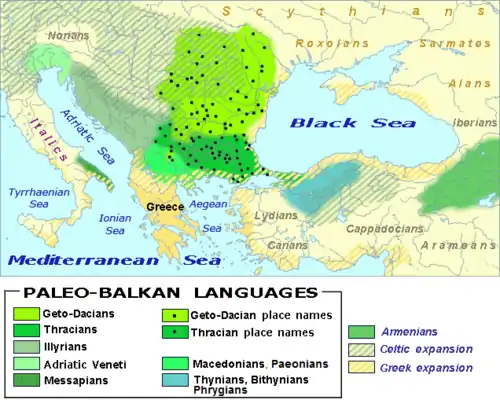
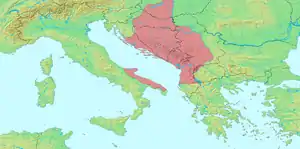
.svg.png.webp)
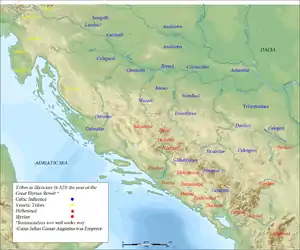
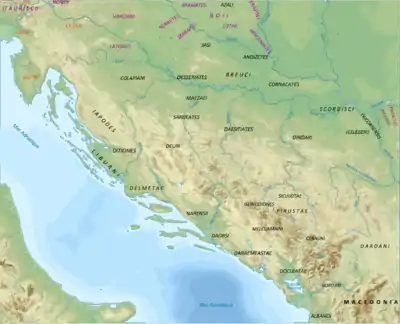
.svg.png.webp)
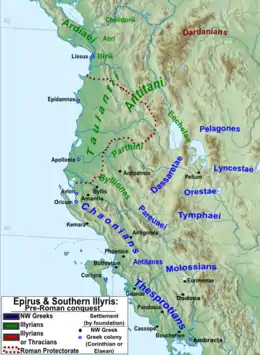
.svg.png.webp)
Dalmatae / Delmatae
Illyrians proper (Illyrii Proprie Dicti)
- Ardiaei / Vardaei / Vardiaei
- Autariatae / Autariates
- Bathiatae
- Cavii
- Chelidones / Chelidonii
- Cinambri/Kinambroi
- Dassareti (Illyrian Dassareti)
- Docleatae / Docletae
- Dyestes
- Penestae (Penesti)
- Selepitani / Selepitanoi
- Taulantii
Pannonians
- Eastern group
- Amantini / Amantes
- Andes / Andizetes
- Azali
- Breuci
- Colapiani
- Oseriates / Osseriates
- Ditiones
- Jasi
- Pirustae / Pirusti
- Ceraunii
- Glintidiones
- Scirtari
- Siculotae
- Western group
- Daesitiates
- Maezaei / Maizaioi / Mazaioi
- Segestani
Possible Illyrian tribes
Possible Illyrian peoples
Paeonians
There are different views and still no agreement among scholars about the Paeonians/Paeones ethnic and linguistic kinship. Some such as Wilhelm Tomaschek and Paul Kretschmer claim that the language spoken by the Paeonians belonged to the Illyrian family, while Dimitar Dechev claims affinities with Thracian. Irwin L. Merker considers that the language spoken by the Paeonians was closely related to Greek (and ancient Macedonian if it was a distinct language from ancient Greek), a Hellenic language with "a great deal of Illyrian and Thracian influence as a result of this proximity".[1]
.svg.png.webp)
- Agrianes[2] (also, Agriani and Agrii) (it is also claimed that this tribe was Thracian)
- Almopians[3] (also Almopioi)
- Derrones[4] (also Derroni) (it is also claimed that this tribe was Thracian)
- Doberes[5]
- Laeaeans[2] (also Laeaei and Laiai)
- Odomantes[6] (also Odomanti) (it is also claimed that this tribe was Thracian)[7]
- Paeoplae[8]
- Siropaiones[9]
See also
- Illyrians
- List of ancient tribes in Illyria
- List of ancient cities in Illyria
- List of rulers of Illyria
- List of ancient tribes in Thrace
- List of ancient cities in Thrace
- List of rulers of Thrace
References
- "The Ancient Kingdom of Paionia". Balkan Studies 6. 1965.
- Early symbolic systems for communication in Southeast Europe, Part 2 by Lolita Nikolova, ISBN 1-84171-334-1, 2003, page 529, "eastern Paionians (Agrianians and Laeaeans)"
- The Landmark Thucydides: A Comprehensive Guide to the Peloponnesian War by Thucydides, Robert B. Strassler, Richard Crawley, and Victor Davis Hanson, 1998, ISBN 0-684-82790-5, page 153,"... of them still live round Physcasb- and the Almopians from Almopia.
- The Cambridge Ancient History, Martin Percival Charlesworth, ISBN 0-521-85073-8, ISBN 978-0-521-85073-5 Volume 4, Persia, Greece and the Western Mediterranean, C. 525 to 479 B.C, John Boardman, page 252, "The Paeonians were the earlier owners of some of these mines, but after their defeat in the coastal sector they maintained their independence in the mainland and coined large denominations in the upper Strymon and the Upper Axius area in the names of the Laeaei and the Derrones"
- The Histories (Penguin Classics) by Herodotus, John M. Marincola, and Aubery de Selincourt, ISBN 0-14-044908-6, 2003, page 452, "... Then he passed through the country of the Doberes and Paeoplae (Paeonian tribes living north of Pangaeum), and continued in a ..."
- An Inventory of Archaic and Classical Poleis: An Investigation Conducted by The Copenhagen Polis Centre for the Danish National Research Foundation by Mogens Herman Hansen and Thomas Heine Nielsen, 2005, ISBN 0-19-814099-1, page 854, ... Various tribes have occupied this part of Thrace: Bisaltians (lower Strymon valley), Odomantes (the plain to the north of the Strymon) ...
- Thrace in the Graeco-Roman world, p. 112 but others claim that together with the Agrianes and Odomanti, at least the latter of which were with certainty Thracian, not Paeonian.
- The Histories (Penguin Classics) by Herodotus, John M. Marincola, and Aubery de Selincourt, ISBN 0-14-044908-6, 2003, page 315, ... "was that a number of Paeonian tribes – the Siriopaeones, Paeoplae, ..."
- The Histories (Penguin Classics) by Herodotus, John M. Marincola, and Aubery de Selincourt, ISBN 0-14-044908-6, 2003, page 315, "... was that a number of Paeonian tribes – the Siriopaeones, Paeoplae, ..."